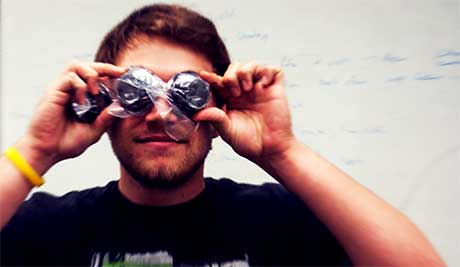
Let’s be honest. All of us nerds (including the closet nerds) have dreamt of a virtual fantasy world in which we can participate in otherworldly experiences together. We want to play without the risk of harm, death or any of the other occupational hazards typical of our favorite protagonists and villains in games, movies and television.
Recent developments in Virtual Reality are inching us ever-closer to the ultimate immersive experience. Star Trek fans rejoiced over the possibility of a fully realized Holodeck with Microsoft’s recent announcement of IllumiRoom. Gamers dropped their jaws when they witnessed even the early private beta versions of the Oculus Rift, a ground-breaking new wearable Virtual Reality device that truly puts a user in the game. These technologies are just the beginning to satisfy the demand for affordable, immersive experiences. Games, movies, music, and live events are just a few of the verticals for these innovations will defy reality and entrance audiences.
This is a special time to be working in the field of Augmented Reality and Virtual Reality. A majority of consumers are carrying supercomputers around in their pockets that will soon be capable of draping the entire world in a fresh virtual canvas. Truly immersing people in the experience and affecting their senses to the point of convincing them that what they are seeing is a monumental task.
Disappointed by past Virtual Reality attempts such as Nintendo’s Virtual Boy, I had all but given up hope until I heard that the Oculus Rift project had announced a renewed crusade to breathe this concept to life on Kickstarter. With the support of top video game companies including Valve, Epic Games and Unity, their campaign was an enormous success. The Oculus project raised over $2.4 million in funding from supporters around the world. We were intrigued and had to get our hands on one. When it showed up at our office, my entire perspective on Virtual Reality shifted.
Oculus Rift: Virtual Reality has arrived for live events. Come ‘rift with us!
Like children unwrapping the birthday present of their dreams, we ripped into the packaging like savages – wait, whom are we kidding? We delicately sliced the packaging open like surgeons and carefully relieved the device from the stylized black development kit. The kit ships with a headset equipped with a high-resolution 1280×800 display, giving each eye a 640×800 stereoscopic viewport. It was very easy to setup and after only 10 minutes of getting everything out of the box we had the demo scene loaded up on one of our laptops.
I was the lucky guy that was first up to get “rifted” as the Oculus development community refers to the use of the technology. I placed the device comfortably on my head and adjusted it to fit my face. The demo was activated and I was instantly transported to a house overlooking the water in full 3D. The device is incredibly smooth and delivers a nearly lag-free experience, even applying motion blur to my viewport as I tried to shake my head and test the true dead reckoning of the device’s motion controller.
Oculus Rift first look photos >>
The most impressive moment was when I looked over each of my shoulders and up into the sky. I realized that I was previewing a primitive version of immersive experiences. The world seamlessly wraps around you and everywhere you look you see the virtual world. Some of us even got hit with some motion sickness from using the device, a feeling that we are calling the Oculus Effect. forcing us to put the device down for a few minutes as our eyes and brains adjusted to this foreign device strapped to our retinas. The device left us feeling excited and excited about the new possibilities and opportunities that this device would bring to the products we develop for our clients and our own internal projects.
Even though it was an amazing experience, it is still in its infancy and has some kinks that need to be worked out. Two come to mind specifically: (1) The ‘screen door’ effect in which you can see the pixels of the screen very closely . This hinders the feeling of that one is truly inside an experience because it is a constant reminder that there is a screen in front of your pupils (2) The device is not wireless due to its reliance on the USB and HDMI ports to transport the video feed and data necessary. Those things aside, I was very impressed with the Oculus Rift, especially since this is only version 0.2 of the product.
Virtual Reality & live experiences
After experiencing the Rift we all had ideas surging through our brains as to how this technology could aid in Marxent’s quest to create the best live experiences for our clients. We envision a world of futuristic Oculus-like devices that are wireless, strapped to our heads and providing a hyper-polished 3D view into the neo-reality that will form when virtual existences supersede those of traditional human existences in the real physical world similar to movies like Avatar, The Matrix, and Surrogates to name a few. The concepts that we’ve been playing with range from virtual trade shows to live and immersive point-of-view experiences.
1. Virtual trade shows and conferences
Imagine a scenario in which all the client would need to bring was a few wearables and some custom software to provide awe-inspiring virtual and augmented experiences for participants at the show. Many industries will benefit from this concept, like museums with ‘real dinosaurs’ and observatories with AR/VR experiences that make it feel as if you are not just looking at the stars, but are traversing them as a virtual space-traveller at superhuman speeds with ease.
2. Pay-per-view “point-of-view” sporting events
The wide world of sports would be forever changed by what I feel could be the next biggest thing to hit the entertainment industry since the invention of the camera or the television: Pay-per-view, point-of-view (PPV-POV) experiences. This would be a service that would be offered to allow users to purchase, subscribe to, and stream the point-of-view of someone else’s wearable device to experience events otherwise intangible. Imagine watching the game from the eyes of your favorite player.
3. Immersive Virtual Reality television events
Virtual Reality has the power to place people in events that they otherwise would never be able to participate in – and from a very specific perspective. Examples might include seeing the Oscars through the eyes of an actress as she accepts an award on stage or watching a favorite episode of Cops from the point-of-view of a sheriff chasing down a bad guy.
Wearable AR & VR changes everything
All of these examples are entertainment experiences that have been unattainable until this new age of wearable AR and VR devices, and the implications of this technology are far-reaching into virtually every industry in existence (no pun intended). Whether it be games, movies, or your entire brand, wearable AR and VR will be the key to separating yourself from the boring and static nature of the current media world and into a dynamic new world in which the rules are defined by the architect of the experience, and in that sense we can bring the mind-bending visions of the greatest science fiction fantasies to life. In the mean time. if any of you need me I’ll be in the Rift.












